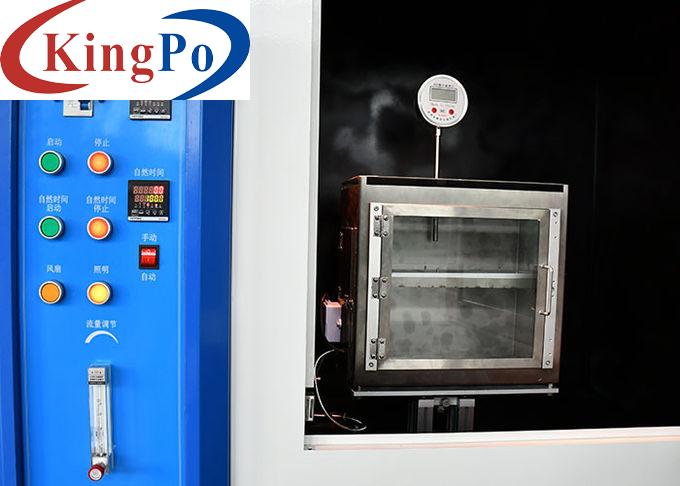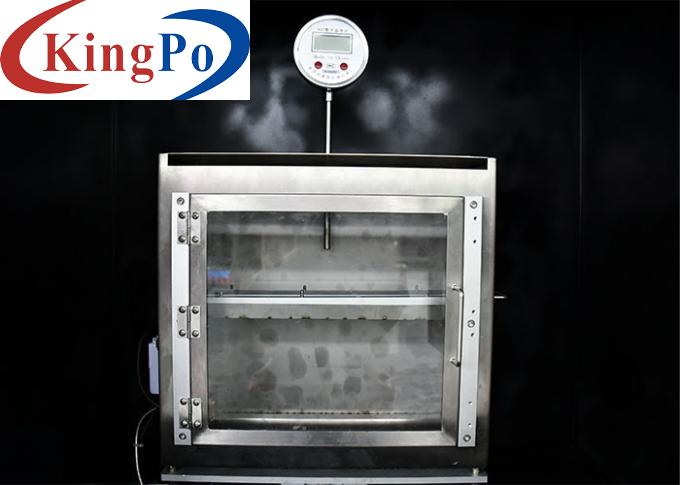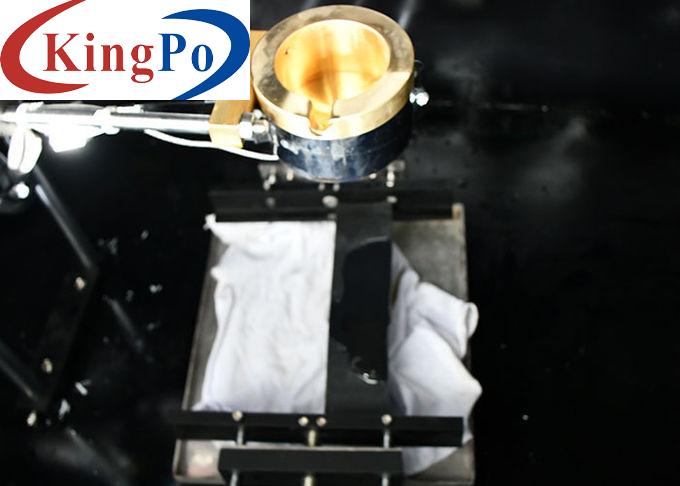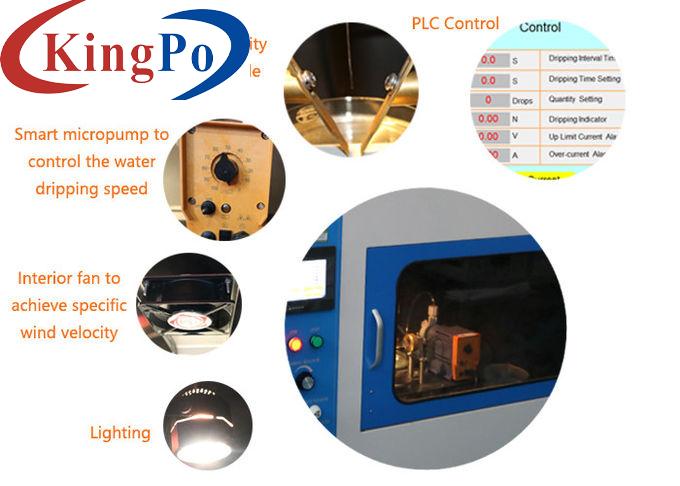Products
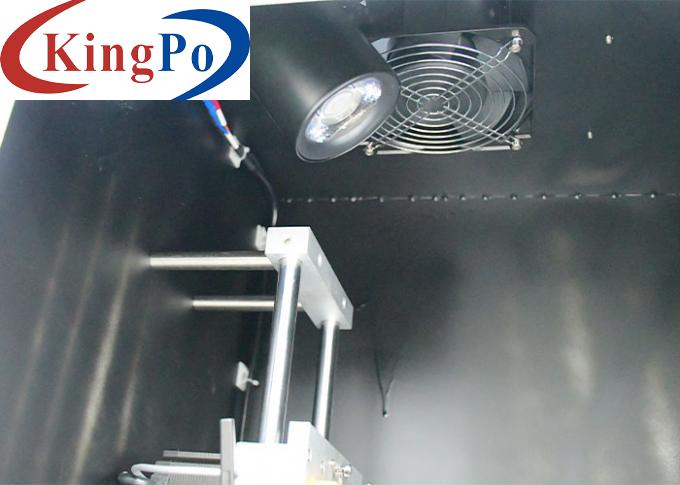
IEC 60950-1 Hot Flaming Oil Test Device Control For Test Flammable Liquids In Electronic Equipment
Products Description
IEC 60950-1 Hot Flaming Oil Test Device Control For Test Flammable Liquids In Electronic Equipment
Product Information:
The flammability test of thermal combustion oil test device is designed and manufactured according to the standard requirements of IEC 62368-1: 2018 Annex S.3, IEC60950-1:2005 and IEC60950-1:2013 clause 4.6.2, Annex A.3 and etc. It is used to simulate that the flammable liquids used in electrical and electronic equipment may ignite due to overheating and leak out of the fire protection enclosure, causing electrical fires and endangering the reliable operation of the equipment and personal safety.
The test process are to fill 10mL of flammable liquid with the specified performance (average calorific value 38MJ/L, mass per unit volume between: 0.845g/mL~0.865g/mL, flash point: 43.5℃~93.5℃) in the metal ladle, after heating to the distillate fuel oil’s ignition point and burning 1mim, the motor drives the spoon to rotate at a certain height (100mm) and a certain flow rate (1mL/s), and then steadily pour the flammable liquid on the center of the opening of the sample (fire protection enclosure). The fire protection performance of the test product is evaluated by whether the ignition bedding at the specified distance (50mm) and with the specified density (40g/m2) under the test product is ignited.
A hot flaming oil test device is a specialized apparatus used to evaluate the fire resistance and performance of materials, products, or components when exposed to hot flaming oil or oil fires. This test is particularly relevant for assessing the fire safety and resistance of materials used in industrial settings, such as electrical enclosures, machinery, or structural components. Here are the key features and components typically found in a hot flaming oil test device:
Test Chamber: The apparatus includes a test chamber or enclosure that can withstand high temperatures and contain the flaming oil during the test. The chamber is typically made of fire-resistant materials, such as stainless steel or refractory materials, to ensure safety and prevent the spread of flames.
Oil Burner System: The oil burner system is responsible for generating a controlled oil fire within the test chamber. It consists of a fuel supply, ignition system, and burner mechanism to deliver a continuous and controlled flame during the test. The burner system is designed to replicate real-world oil fire conditions.
Temperature Measurement: The apparatus incorporates temperature measurement devices, such as thermocouples or infrared sensors, to monitor and record the temperature inside the test chamber. This allows for accurate evaluation of the heat exposure to the tested materials.
Sample Holder or Mounting System: The apparatus includes a sample holder or mounting system to position and secure the test specimens or components within the test chamber. This ensures consistent and repeatable test conditions for accurate comparisons.
Gas Exhaust System: To remove combustion byproducts and maintain a controlled environment, the apparatus is equipped with a gas exhaust system. This system safely vents the combustion gases and fumes generated during the test, preventing their accumulation within the test chamber.
Safety Features: Safety considerations are crucial in the design of the apparatus to protect operators and prevent accidents. This may include safety interlocks, emergency shut-off systems, fire suppression mechanisms, and protective enclosures to contain flames and prevent their spread.
Control System: The apparatus incorporates a control system that allows users to set and adjust various parameters, such as oil flow rate, flame intensity, and test duration. The control system ensures precise control over the test conditions and facilitates the safe operation of the apparatus.
Data Acquisition and Analysis: The apparatus may have data acquisition and analysis capabilities to record and analyze the test results. This can include monitoring factors such as temperature profiles, flame behavior, and any signs of ignition or damage observed during the test.
The hot flaming oil test device is a critical tool for assessing the fire resistance and performance of materials and components in industrial environments. By subjecting them to controlled oil fires, this test helps identify potential fire hazards, evaluate the effectiveness of fire-resistant materials, and guide the development of safer and more reliable products. The test results aid in compliance with fire safety regulations, improving the design of materials and components, and ensuring the protection of personnel and property in high-risk settings.
Technical parameters:
Applied standard
IEC 62368-1
Applied clause
Annex S.3
Control method
Integrated PLC & touch screen
Supply voltage
Match client’s local power supply requirements
The oil of test
Average calorific value 38MJ/L, mass per unit volume between: 0.845g/mL~0.865g/mL, flash point: 43.5℃~93.5℃
Volume of ladle
>10mL
Hot flaming oil burning time
1 min (1s~999999s can be preset)
Hot flaming oil pouring speed
1 ml/s
Hot flaming oil pouring height
100mm
Hot flaming oil pouring time
10s (1s~999999s can be preset)
Ignition bedding material
Bleached CHEESECLOTH of approximately 40 g/m2
Distance between ignition bedding material and sample
Ignition bedding material is under the sample about 50mm
Test area background color
Black
Equipment size & weight
1130mm* 600mm* 1400mm, with a vent port of ф100mm, 147KGS



